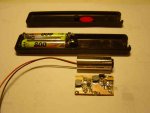phenol
0
- Joined
- Oct 30, 2007
- Messages
- 533
- Points
- 18
for sure u could keep the bulky 47uf on the board. the ceramic one should remain on th leads for best high freq suppression, though.
regarding eff - what inductors are u using? i have only tested it at a fixed Vout of 2.74V and variable Vin and it remained fairly constant over the operating range, deteriorating a bit around the lower margin of Vin
regarding eff - what inductors are u using? i have only tested it at a fixed Vout of 2.74V and variable Vin and it remained fairly constant over the operating range, deteriorating a bit around the lower margin of Vin




